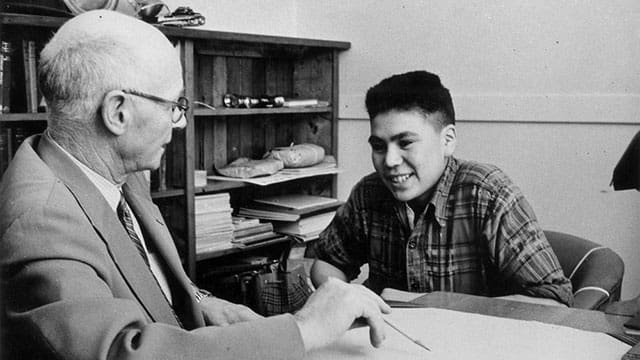Claims of cultural genocide at residential schools are based on weak evidence and ignore historical facts
 The claim that Canada’s Indian Residential Schools (IRSs) perpetuated massive cultural genocide is now accepted wisdom.
The claim that Canada’s Indian Residential Schools (IRSs) perpetuated massive cultural genocide is now accepted wisdom.
Distinguished Canadians such as former Supreme Court Chief Justice Beverley McLachlin and ex-prime minister Paul Martin have publicly endorsed the notion. Even previous Conservative Prime Minister Stephen Harper, although he refrained from using the term in his 2008 Parliamentary statement of apology to former IRS students, acknowledged the IRS tried to “kill the Indian in the child.”
The commission of cultural genocide is an indisputable historical fact according to the six-volume 2015 Truth Reconciliation Commission (TRC) report, a view reinforced in a just-released study from the Office of the Independent Special Interlocutor for Missing Children and Unmarked Graves and Burial Sites associated with Indian Residential Schools.
These charges of deliberate cultural destruction explain the recommendations calling for legal, political, and economic restitution based on the assumption that the schools systematically engaged in the annihilation of those structures and practices that allow a group’s distinctive to survive by banning language use, forbidding spiritual practices, and disrupting traditional family life to prevent the inter-generational transmission of cultural values and identity.
 Image by Hugh Allan, Winnipeg Tribune / Library and Archives Canada / Department of Indian Affairs and Northern Development. |
| Related Stories |
| Why is Trudeau sticking to the unmarked graves hoax?
|
| Catholic Church finally repudiates the Doctrine of Discovery
|
| House of Commons finally describes residential schools as genocide
|
In recent years, the phrase cultural genocide has been used to describe U.S. treatment of its native peoples, Russian treatment of Jews, Israeli treatment of Palestinians, and Communist China’s treatment of Tibetans. With its endorsements by numerous prominent Canadians and Indigenous-led studies, it has achieved widespread currency in Canada: a July 2015 Angus Reid poll found that 70 percent of Canadians agreed that cultural genocide described the IRS experience.
Like much received wisdom – the set of beliefs people have come to accept as true regardless of their accuracy – there is little factual evidence supporting the cultural genocide notion.
As is well-documented, Christianity flourished in aboriginal communities across Canada from first contact onwards. So did a desire to internalize European ways of understanding and dealing with the world. Thus, generations of Christian aboriginal parents willingly sent their children to the church-operated residential schools to obtain an education, often alongside European classmates – the sons and daughters of missionaries, Hudson Bay Company personnel, and Indian Affairs employees – a fact the TRC and other reports chose to ignore.
As late as the 1940s and 1950s, when the Indian Act was being amended, many bands and native organizations asked for the schools to remain open. In the 1960s, well after most of the Indian Residential Schools had already been closed, several bands lobbied the Department of Indian Affairs to keep some of the remaining schools operating.
The cultural genocide charge is also rooted in weak social science. The legacy of the IRS – “the significant educational, income, health, and social disparities between Aboriginal people and other Canadians,” the negative effects of poor, abusive, or absent parenting, and high incarceration rates – has been found to be no greater among those who attended IRS than those who did not.
Moreover, the cultural genocide thesis ignores the indisputable fact that human beings can internalize features of two or more cultures, including unrelated languages. The TRC Report implies that cultural learning and retention are zero-sum games, ignoring the abundant evidence to the contrary. The truth of this is clearly seen in the diversity of Canadian society, where people from a vast array of cultures have successfully integrated into the multicultural mainstream while retaining many of their native languages, beliefs, and cultural practices.
The TRC Report grudgingly (and perhaps inadvertently) acknowledges that this is as true for Aboriginal Canadians as it is for millions of other Canadians when it states that “Aboriginal cultures and peoples have been badly damaged, [but] they continue to exist. Aboriginal people have refused to surrender their identity.”
This may be the truest statement in the Report, and perhaps the most hopeful one, for it acknowledges that as hard as the IRS may have tried to absorb its students into mainstream culture (i.e., “to kill the Indian in the child”), these efforts failed. The statement also transcends the bitter and hyperbolic narrative of genocide and entitlement, and points to a future where a proud and confident people are recognized – and recognize themselves – as full and equal citizens of Canada, instead of its eternal victims.
Hymie Rubenstein, editor of REAL Indigenous Report, is a retired professor of anthropology, University of Manitoba. He is co-author of Residential School Recrimination, Repentance, and Reality for the Frontier Centre for Public Policy, where he is a senior fellow.
For interview requests, click here.
The opinions expressed by our columnists and contributors are theirs alone and do not inherently or expressly reflect the views of our publication.
© Troy Media
Troy Media is an editorial content provider to media outlets and its own hosted community news outlets across Canada.

